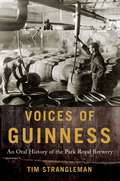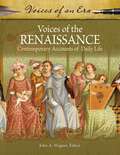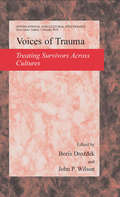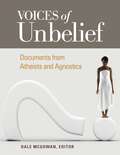- Table View
- List View
Voices of Guatemalan Women in Los Angeles: Understanding Their Immigration (Latino Communities: Emerging Voices - Political, Social, Cultural and Legal Issues)
by Gabriele KohpahlFirst published in 1999. Guatemalan immigration is part of a trend where more women in an increasing number of countries than men participate in transnational migration. This research attempts to clarify the causes for this phenomenon. First, it evaluates which Guatemalan women initiators and pioneers in the decision to migrate. Second, it looks at women's diverse reasons for leaving Guatemala, and third, what are the conditions particular to women left behind? This study will also contribute to an understanding of the increasing diversification of the Latin American immigrant population in the United States.
Voices of Guatemalan Women in Los Angeles: Understanding Their Immigration (Latino Communities: Emerging Voices - Political, Social, Cultural and Legal Issues)
by Gabriele KohpahlFirst published in 1999. Guatemalan immigration is part of a trend where more women in an increasing number of countries than men participate in transnational migration. This research attempts to clarify the causes for this phenomenon. First, it evaluates which Guatemalan women initiators and pioneers in the decision to migrate. Second, it looks at women's diverse reasons for leaving Guatemala, and third, what are the conditions particular to women left behind? This study will also contribute to an understanding of the increasing diversification of the Latin American immigrant population in the United States.
Voices of Guinness: An Oral History of the Park Royal Brewery (Oxford Oral History Series)
by Tim StranglemanImagine a workplace where workers enjoyed a well-paid job for life, one where they could start their day with a pint of stout and a smoke, and enjoy free meals in silver service canteens and restaurants. During their breaks they could explore acres of parkland planted with hundreds of trees and thousands of shrubs. Imagine after work a place where employees could play more than thirty sports, or join one of the theater groups or dozens of other clubs. Imagine a place where at the end of a working life you could enjoy a company pension from a scheme to which you had never contributed a penny. Imagine working in buildings designed by an internationally renowned architect whose brief was to create a building that "would last a century or two." This is no fantasy or utopian vision of work but a description of the working conditions enjoyed by employees at the Guinness brewery established at Park Royal in West London in the mid-1930s. In this book, Tim Strangleman tells the story of the Guinness brewery at Park Royal, showing how the history of one plant tells us a much wider story about changing attitudes and understandings about work and the organization in the twentieth and early twenty-first centuries. Drawing on extensive oral history interviews with staff and management as well as a wealth of archival and photographic sources, the book shows how progressive ideas of workplace citizenship came into conflict with the pressure to adapt to new expectations about work and its organization. Strangleman illustrates how these changes were experienced by those on the shop floor from the 1960s through to the final closure of the plant in 2005. This book asks striking and important questions about employment and the attachment workers have to their jobs, using the story of one of the UK and Ireland's most beloved brands, Guinness.
Voices of Guinness: An Oral History of the Park Royal Brewery (Oxford Oral History Series)
by Tim StranglemanImagine a workplace where workers enjoyed a well-paid job for life, one where they could start their day with a pint of stout and a smoke, and enjoy free meals in silver service canteens and restaurants. During their breaks they could explore acres of parkland planted with hundreds of trees and thousands of shrubs. Imagine after work a place where employees could play more than thirty sports, or join one of the theater groups or dozens of other clubs. Imagine a place where at the end of a working life you could enjoy a company pension from a scheme to which you had never contributed a penny. Imagine working in buildings designed by an internationally renowned architect whose brief was to create a building that "would last a century or two." This is no fantasy or utopian vision of work but a description of the working conditions enjoyed by employees at the Guinness brewery established at Park Royal in West London in the mid-1930s. In this book, Tim Strangleman tells the story of the Guinness brewery at Park Royal, showing how the history of one plant tells us a much wider story about changing attitudes and understandings about work and the organization in the twentieth and early twenty-first centuries. Drawing on extensive oral history interviews with staff and management as well as a wealth of archival and photographic sources, the book shows how progressive ideas of workplace citizenship came into conflict with the pressure to adapt to new expectations about work and its organization. Strangleman illustrates how these changes were experienced by those on the shop floor from the 1960s through to the final closure of the plant in 2005. This book asks striking and important questions about employment and the attachment workers have to their jobs, using the story of one of the UK and Ireland's most beloved brands, Guinness.
Voices of Innovation - Payers: Opportunities for Creating Solutions to Improve Member Experience and Health
by Edward W. Marx Sakshika DhingraAs the health delivery landscape in the United States evolves in a post-COVID-19 era, both incumbents and new entrants are reimagining models of care. Technology and medical advancements are transforming the way care is delivered and experienced, and changes in regulations and incentives across the industry are redefining how the healthcare system works and interacts. As a result, care delivery is undergoing several transformations: from sick care to preventative whole-person care, from intermittent to continuous care, from facility-based settings to omnichannel offerings through virtual care and video or telephonic technologies, and from standardized to personalized solutions. In addition to healthcare providers, payers are also redefining their role in care delivery through provider ownership, technology, and provider enablement to deliver higher-value care to members. While the payer community has been slow to innovate, they now have an opportunity and an incentive to play an active role in reimagining the future of care delivery. In the past year alone, significant disruptors have entered the provider space threatening the existence of payers, specifically self-funded programs such as Amazon and Walmart. This has served as a giant wake-up call that healthcare has shifted. Now, more than ever, there is an emphasis on the patient and clinician experience. Perhaps hastened by the pandemic, the race is on for innovations from the payer community to improve patient and provider engagement. Unlike other players, payers have end-to-end visibility into individual care needs and utilization patterns across providers and settings. This perspective can provide informed choices around optimal care models, unlock value through improved health outcomes, and lower the total cost of care for members and customers. This book is loaded with numerous case studies and interviews with healthcare leaders from the payer community, helping stakeholders understand how to leverage innovation leading them to superior business and clinical outcomes. The book also discusses how and why data is key to innovation activities and how partnerships are key to using data effectively.
Voices of Innovation - Payers: Opportunities for Creating Solutions to Improve Member Experience and Health
by Edward W. Marx Sakshika DhingraAs the health delivery landscape in the United States evolves in a post-COVID-19 era, both incumbents and new entrants are reimagining models of care. Technology and medical advancements are transforming the way care is delivered and experienced, and changes in regulations and incentives across the industry are redefining how the healthcare system works and interacts. As a result, care delivery is undergoing several transformations: from sick care to preventative whole-person care, from intermittent to continuous care, from facility-based settings to omnichannel offerings through virtual care and video or telephonic technologies, and from standardized to personalized solutions. In addition to healthcare providers, payers are also redefining their role in care delivery through provider ownership, technology, and provider enablement to deliver higher-value care to members. While the payer community has been slow to innovate, they now have an opportunity and an incentive to play an active role in reimagining the future of care delivery. In the past year alone, significant disruptors have entered the provider space threatening the existence of payers, specifically self-funded programs such as Amazon and Walmart. This has served as a giant wake-up call that healthcare has shifted. Now, more than ever, there is an emphasis on the patient and clinician experience. Perhaps hastened by the pandemic, the race is on for innovations from the payer community to improve patient and provider engagement. Unlike other players, payers have end-to-end visibility into individual care needs and utilization patterns across providers and settings. This perspective can provide informed choices around optimal care models, unlock value through improved health outcomes, and lower the total cost of care for members and customers. This book is loaded with numerous case studies and interviews with healthcare leaders from the payer community, helping stakeholders understand how to leverage innovation leading them to superior business and clinical outcomes. The book also discusses how and why data is key to innovation activities and how partnerships are key to using data effectively.
Voices of Intimate Partner Homicide: An Exploration of Coercive Control and Lethality
by Donna J. KingIn the United States and most parts of the world, law, policy, policing, and prevention work addressing domestic and intimate partner violence is created and enacted based on a violence model. Likewise, it is generally believed that all victims of intimate partner homicide are victims of intimate partner violence, through physical abuse, prior to the incident of homicide, and that this violence is reported beforehand.Voices of Intimate Partner Homicide takes a critical look at these misconceived notions and sheds light on multiple non-violent forms of controlling behavior that precipitate intimate partner homicide. The book bases its critical examination on a content analysis of court-filed Petitions for Injunction for Protection Against Domestic Violence. Through these records, as well as corresponding police and homicide reports, the accounts of the victims, and their relationships with their offenders, come to life. Recurring coercive control tactics are coded and analyzed across multiple accounts, including intimidation, isolation, and humiliation, to illustrate the ways in which individuals are threatened prior to homicide and the true extent of harm that happens in the absence of physical violence. Considering the victim’s responses, as well as their interaction with law enforcement and the court system prior to their death, the author challenges current legal and policy initiatives made to address and protect victims from intimate partner violence and argues that non-violent controlling behaviors deserve more attention in lethality risk assessments that are utilized throughout the United States.For practitioners, advocates, researchers, and students, this book provides an intimate and important account of the causes and consequences of intimate partner violence prior to homicide and a rare window into the victim’s overall experience.
Voices of Intimate Partner Homicide: An Exploration of Coercive Control and Lethality
by Donna J. KingIn the United States and most parts of the world, law, policy, policing, and prevention work addressing domestic and intimate partner violence is created and enacted based on a violence model. Likewise, it is generally believed that all victims of intimate partner homicide are victims of intimate partner violence, through physical abuse, prior to the incident of homicide, and that this violence is reported beforehand.Voices of Intimate Partner Homicide takes a critical look at these misconceived notions and sheds light on multiple non-violent forms of controlling behavior that precipitate intimate partner homicide. The book bases its critical examination on a content analysis of court-filed Petitions for Injunction for Protection Against Domestic Violence. Through these records, as well as corresponding police and homicide reports, the accounts of the victims, and their relationships with their offenders, come to life. Recurring coercive control tactics are coded and analyzed across multiple accounts, including intimidation, isolation, and humiliation, to illustrate the ways in which individuals are threatened prior to homicide and the true extent of harm that happens in the absence of physical violence. Considering the victim’s responses, as well as their interaction with law enforcement and the court system prior to their death, the author challenges current legal and policy initiatives made to address and protect victims from intimate partner violence and argues that non-violent controlling behaviors deserve more attention in lethality risk assessments that are utilized throughout the United States.For practitioners, advocates, researchers, and students, this book provides an intimate and important account of the causes and consequences of intimate partner violence prior to homicide and a rare window into the victim’s overall experience.
Voices of Man: The Meaning and Function of Language (World Perspectives #8)
by Mario PeiOriginally published in 1964, this book examines where and how the pattern and texture of speech emerged and whether language is logical. It looks at linguistics from both the historical and descriptive points of view, as a physical science and as a social science. It also discusses the problem of aesthetics in language and what happens when different languages come into contact with each other. The book concludes with a discussion of the possibility of an international language, and indeed whether such a development would be progress or something that is needed or wanted.
Voices of Man: The Meaning and Function of Language (World Perspectives #8)
by Mario PeiOriginally published in 1964, this book examines where and how the pattern and texture of speech emerged and whether language is logical. It looks at linguistics from both the historical and descriptive points of view, as a physical science and as a social science. It also discusses the problem of aesthetics in language and what happens when different languages come into contact with each other. The book concludes with a discussion of the possibility of an international language, and indeed whether such a development would be progress or something that is needed or wanted.
Voices of Resilience
by Pam O’Connor Jaya EarnestThis book presents the results of a study that examined the multiple layers of stigma and discrimination experienced by women infected and affected by HIV/AIDS in a low socio-economic area of Mumbai, India. Using exploratory qualitative methods and underpinned by the psychosocial framework and gendered perspectives the study attempts to represent the voicesof affected and infected women. The book first focuses on a global overview of HIV,presents data on the Indian context and provides a synthesis of HIV in relation to stigma, discrimination and gender. The second part of the book probes the depth of impact on women’s lives using the lenses of gender, economic status, the environment and physical health. The framework was further modified and extended to include threats revealed by and strengths indentified in infected and affected women. The analysis revealed that strategies to address stigma and discrimination need to address the social, cultural, religious and systemic barriers to changing attitudes. The book portrays the resilience of each woman’s spirit and the unique capacity of the women to cope, to find strength, to pursue life and to maintain hope when their dreams and the dreams of their children have been shattered through HIV/AIDS.
Voices of South Asia: Essential Readings from Antiquity to the Present
by Patrick PeeblesAn ideal supplement for any course treating the history or culture of South Asia, this collection offers a cross-section of South Asia's ancient and modern classics of thought and expression. It includes a unique mix of poetry, novels, drama, and political and philosophical treatises, each accompanied by a detailed introductory essay on the specific historical context, the author, and the work.
Voices of South Asia: Essential Readings from Antiquity to the Present
by Patrick PeeblesAn ideal supplement for any course treating the history or culture of South Asia, this collection offers a cross-section of South Asia's ancient and modern classics of thought and expression. It includes a unique mix of poetry, novels, drama, and political and philosophical treatises, each accompanied by a detailed introductory essay on the specific historical context, the author, and the work.
Voices of the Renaissance: Contemporary Accounts of Daily Life (Voices of an Era)
by John A. WagnerThe documents in this collection trace the course of the Renaissance in Italy and northern Europe, describing the emergence of a vibrant and varied intellectual and artistic culture in various states, cities, and kingdoms.Voices of the Renaissance: Contemporary Accounts of Daily Life contains excerpts from 52 different documents relating to the period of European history known as the Renaissance. In the 14th century, the rise of humanism, a philosophy based on the study of the languages, literature, and material culture of ancient Greece and Rome, led to a sense of revitalization and renewal among the city-states of northern Italy. The political development and economic expansion of those cities provided the ideal conditions for humanist scholarship to flourish. This period of literary, artistic, architectural, and cultural flowering is today known as the Renaissance, a term taken from the French and meaning "rebirth."The Italian Renaissance reached its height in the 15th and early 16th centuries. In the 1490s, the ideals of the Italian Renaissance spread north of the Alps and gave rise to a series of national cultural rebirths in various states. In many places, this Northern Renaissance extended into the 17th century, when war and religious discord put an end to the Renaissance era.
Voices of the Renaissance: Contemporary Accounts of Daily Life (Voices of an Era)
by John A. WagnerThe documents in this collection trace the course of the Renaissance in Italy and northern Europe, describing the emergence of a vibrant and varied intellectual and artistic culture in various states, cities, and kingdoms.Voices of the Renaissance: Contemporary Accounts of Daily Life contains excerpts from 52 different documents relating to the period of European history known as the Renaissance. In the 14th century, the rise of humanism, a philosophy based on the study of the languages, literature, and material culture of ancient Greece and Rome, led to a sense of revitalization and renewal among the city-states of northern Italy. The political development and economic expansion of those cities provided the ideal conditions for humanist scholarship to flourish. This period of literary, artistic, architectural, and cultural flowering is today known as the Renaissance, a term taken from the French and meaning "rebirth."The Italian Renaissance reached its height in the 15th and early 16th centuries. In the 1490s, the ideals of the Italian Renaissance spread north of the Alps and gave rise to a series of national cultural rebirths in various states. In many places, this Northern Renaissance extended into the 17th century, when war and religious discord put an end to the Renaissance era.
Voices of Transgender Children in Early Childhood Education: Reflections on Resistance and Resiliency (Critical Cultural Studies of Childhood)
by Ashley L. Sullivan Laurie L. UrraroThis volume explores transgender children and internalized body normalization in early childhood education settings, steeped in critical methodologies including post-structuralism, queer theory, and feminist approaches. The book marries theory and praxis, submitting to current and future teachers a text that not only presents authentic narratives about trans children in early childhood education, but also analyzes the forces at work behind gender policing, gender segregation, and transphobic education policies. As the struggles and triumphs of trans individuals have reached a watershed moment in the social fabric of the United States, this text offers a snapshot into the lives of ten transgender people as they reflect on their earliest memories in the American educational system.
Voices of Trauma: Treating Psychological Trauma Across Cultures (International and Cultural Psychology)
by Boris Drozdek John P. WilsonSynthesizing insights from psychiatry, social psychology, and anthropology, this important work sets out a framework for therapy that is as culturally informed as it is productive. An international panel of 23 therapists offers contextual knowledge on PTSD, coping skills, and other sequelae experienced by the survivors of traumatic events. Case studies from Egypt to Chechnya demonstrate various therapeutic approaches. Authors explore the balance of inter- and intrapersonal factors in reactions to trauma and dispel misconceptions that hinder progress in treatment.
Voices of Unbelief: Documents from Atheists and Agnostics (Voices Of An Era Ser.)
by Dale McGowanThis book spotlights individual expressions of atheist, agnostic, and secular humanist opinion—both public and private—to shed light on the phenomenon of religious disbelief throughout history and across cultures.Voices of Unbelief: Documents from Atheists and Agnostics is the first anthology to provide comprehensive, annotated readings on atheism and unbelief expressly for high school and college students. This diverse compilation brings together letters, essays, diary entries, book excerpts, blogs, monologues, and other writings by atheists and agnostics, both through the centuries and across continents and cultures.Unlike most other anthologies of atheist writings, the collection goes beyond public proclamations of well-known individuals to include the personal voices of unbelievers from many walks of life. While readers will certainly find excerpts from the published canon here, they will also discover personal documents that testify to the experience of living outside of the religious mainstream. The book presents each document in its historical context, enriched with an introduction, key questions, and activities that will help readers understand the past and navigate current controversies revolving around religious belief.
Voices of Unbelief: Documents from Atheists and Agnostics
by Dale McGowanThis book spotlights individual expressions of atheist, agnostic, and secular humanist opinion—both public and private—to shed light on the phenomenon of religious disbelief throughout history and across cultures.Voices of Unbelief: Documents from Atheists and Agnostics is the first anthology to provide comprehensive, annotated readings on atheism and unbelief expressly for high school and college students. This diverse compilation brings together letters, essays, diary entries, book excerpts, blogs, monologues, and other writings by atheists and agnostics, both through the centuries and across continents and cultures.Unlike most other anthologies of atheist writings, the collection goes beyond public proclamations of well-known individuals to include the personal voices of unbelievers from many walks of life. While readers will certainly find excerpts from the published canon here, they will also discover personal documents that testify to the experience of living outside of the religious mainstream. The book presents each document in its historical context, enriched with an introduction, key questions, and activities that will help readers understand the past and navigate current controversies revolving around religious belief.
Voicing Politics: How Language Shapes Public Opinion (Princeton Studies in Political Behavior #45)
by Efrén Pérez Margit TavitsWhy your political beliefs are influenced by the language you speakVoicing Politics brings together the latest findings from psychology and political science to reveal how the linguistic peculiarities of different languages can have meaningful consequences for political attitudes and beliefs around the world. Efrén Pérez and Margit Tavits demonstrate that different languages can make mental content more or less accessible and thereby shift political opinions and preferences in predictable directions. They rigorously test this hypothesis using carefully crafted experiments and rich cross-national survey data, showing how language shapes mass opinion in domains such as gender equality, LGBTQ rights, environmental conservation, ethnic relations, and candidate evaluations.Voicing Politics traces how these patterns emerge in polities spanning the globe, shedding essential light on how simple linguistic quirks can affect our political views. This incisive book calls on scholars of political behavior to take linguistic nuances more seriously and charts new directions for researchers across diverse fields. It explains how a stronger grasp of linguistic effects on political cognition can help us better understand how people form political attitudes and why political outcomes vary across nations and regions.
Voicing Politics: How Language Shapes Public Opinion (Princeton Studies in Political Behavior #45)
by Efrén Pérez Margit TavitsWhy your political beliefs are influenced by the language you speakVoicing Politics brings together the latest findings from psychology and political science to reveal how the linguistic peculiarities of different languages can have meaningful consequences for political attitudes and beliefs around the world. Efrén Pérez and Margit Tavits demonstrate that different languages can make mental content more or less accessible and thereby shift political opinions and preferences in predictable directions. They rigorously test this hypothesis using carefully crafted experiments and rich cross-national survey data, showing how language shapes mass opinion in domains such as gender equality, LGBTQ rights, environmental conservation, ethnic relations, and candidate evaluations.Voicing Politics traces how these patterns emerge in polities spanning the globe, shedding essential light on how simple linguistic quirks can affect our political views. This incisive book calls on scholars of political behavior to take linguistic nuances more seriously and charts new directions for researchers across diverse fields. It explains how a stronger grasp of linguistic effects on political cognition can help us better understand how people form political attitudes and why political outcomes vary across nations and regions.
Volk - Staat - (Welt-)Gesellschaft: Zur Konstruktion und Rekonstruktion von Kollektivität in einer globalisierten Welt
by Katja JungDie Frage, was die Gesellschaft in ihrem Innersten zusammenhält, scheint auf besonders empfindsame Weise den Nerv der Gegenwart zu treffen. Das gilt offenbar umso mehr für all jene gesellschaftstheoretischen Beschreibungen, die im Modus des Krisenhaften ebenso Kritik am Verlust von Solidarischem üben wie sie an eine Rekonstruktion derselben jenseits alter Formen appellieren, um daran einen epochalen Wandel beispielloser Art zu diagnostizieren. Die vorliegende Untersuchung bricht mit einem derartigen Verständnis und geht davon aus, dass die Frage nach dem Zusammenhalt der Gesellschaft selbst eine ganz spezifisch moderne Beschreibungspraxis darstellt. Anhand einer sozialtheoretischen Aufarbeitung von klassischen Ansätzen einerseits und soziologischen Positionen der Gegenwart andererseits versucht die Studie zu zeigen, dass das, was bislang Lösung war, nun zum eigentlichen Problem geworden ist.
Volk und Staat: Geschichtliche Abhandlungen aus dem „Schwarzen Korps“
by Heinar SchillingDieser Buchtitel ist Teil des Digitalisierungsprojekts Springer Book Archives mit Publikationen, die seit den Anfängen des Verlags von 1842 erschienen sind. Der Verlag stellt mit diesem Archiv Quellen für die historische wie auch die disziplingeschichtliche Forschung zur Verfügung, die jeweils im historischen Kontext betrachtet werden müssen. Dieser Titel erschien in der Zeit vor 1945 und wird daher in seiner zeittypischen politisch-ideologischen Ausrichtung vom Verlag nicht beworben.
Volkseigenes Erinnern: Die DDR im sozialen Gedächtnis (Soziales Gedächtnis, Erinnern und Vergessen – Memory Studies)
by Hanna Haag Pamela Heß Nina LeonhardDie Beiträge untersuchen aus unterschiedlichen Blickwinkeln die Modalitäten der selektiven Inanspruchnahme von DDR-bezogenen Wissensbeständen für individuelle wie kollektive Sinnbildung, wie sie sich im Verlauf der letzten zweieinhalb Jahrzehnte im vereinigten Deutschland herausgebildet haben. Hierbei stehen weniger die ‚offiziellen‘, das heißt die institutionell abgesicherten Sichtweisen auf die DDR im Fokus der Betrachtung. Vielmehr nehmen die Autorinnen und Autoren Formen der sozialen Aneignung (oder auch: der Nicht-Aneignung) dieser sowie anderer, teilweise noch wenig untersuchter DDR-bezogener Wissensbestände ‚von unten‘ in den Blick und liefern so Erkenntnisse über die Formierung der DDR als Gegenstand sozialer Erinnerungs- und Vergessensprozesse seit 1990.
Volkswirtschaftslehre für Sozialwissenschaftler: Einführung in eine zukunftsfähige Wirtschaftslehre
by Holger RogallDas Buch bietet eine systematische und allgemeinverständliche Einführung in die Volkswirtschaftslehre und gibt dem Leser das wirtschaftswissenschaftliche Wissen an die Hand mit dem er die nationalen und globalen Wirtschaftsprozesse und -zusammenhänge verstehen kann. Die wichtigsten Theorien, mit denen sich die ökonomischen Handlungen der Wirtschaftsakteure erklären lassen, werden erläutert. Den Modellen wird eine praxisbezogene Analyse wirtschaftlicher Entscheidungsprozesse gegenübergestellt. Diese sind wesentlich öfter von Erwartungen und gesellschaftspolitischen Interessen bestimmt, als dies viele Wirtschaftswissenschaftler wahrnehmen. Darüber hinaus erfolgt eine Auseinandersetzung mit den wichtigsten nationalen und globalen Zielen, die eine auf Zukunftsfähigkeit angelegte Wirtschaftspolitik in einer globalisierten Welt erreichen will. Die Schwierigkeiten, diese Ziele zu erreichen, werden dargestellt und Lösungsstrategien herausgearbeitet. Das Werk wurde für die zweite Auflage grundlegend überarbeitet und aktualisiert.

















